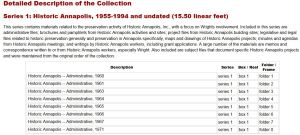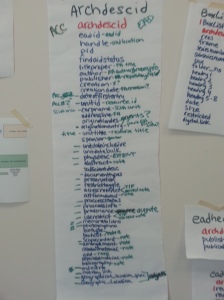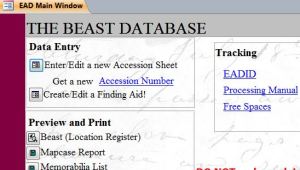This post has been stewing around since last July, but builds nicely on our Extensible Processing book reviews and Maureen’s post on containers.
In supervising processing projects I’ve come across some wacky decisions made over the years. While I’ve started projects from the beginning, a large portion of projects I’ve supervised have been already in progress, started under someone else (or multiple others).
One reoccurring issue I’ve noticed is how often people say processing when they mean something else or they mean a very small part of processing. Rehousing is a common culprit, but other activities fall into this too. Here’s two examples of “processing projects” that mostly aren’t at all:
1. Collection was processed in the 1970s. A paper finding exists with notes, series descriptions, and a folder (or item) level container list. Materials are in acidic boxes and acidic folders, but labeled. Actions taken during the project: Rehoused all materials into acid-free folders and acid-free boxes, including creating additional, smaller folders. Changed the series arrangement and physically re-arranged materials. Excel container list was created by retyping (retyping!) the content of the paper finding aid and adding in the newly created folders for conversion to EAD.
So many times I came across similar ongoing processing projects with a justification that the materials needed better housing. Often, other tasks got tacked on such as redoing the series outline (even if there were no additional materials to add and no evidence that the current series outline had issues.)
2. Preliminary inventory in Word exists at the folder level using creator created titles for a large volume of organizational records. Finding aid existed with summary notes and linked out to a PDF of the preliminary inventory. Actions taken during project:
- Collection was rehoused into acid-free folders, staples removed, some preservation photocopying done, oversize materials removed and rehoused separately (separation sheets completed)
- Materials were reviewed on an item level and marked as restricted. Some redaction might have happened. Sometimes the restricted materials were removed to a new folder with the same title and marked as restricted (using separation sheets in the original folder). Sometimes the restricted materials were left in place and the whole folder was labeled restricted.
- Excel container list was created by retyping (retyping!) the exact information on the folder (aka the exact information already in the preliminary Word list) as materials were re-foldered. Largely, the creator titles were kept with some additions. Dates for folders were added or edited. Excel list will be converted to EAD.
- Folders were physically grouped by letter of alphabet based on the folder title. Ex: All the folders starting with “A” are physically together in “A” boxes, but not in actual alphabetical order yet. (Currently, those folders are being arranged in alphabetical order in acid-free boxes. Look for an update on how long/how expensive just this one phase takes!)
Both of these examples were large projects that occurred over many years (often with pauses due to turn over and lack of resources). Looking back, what value did we add? The collections are in more stable housing than before and in one case we know more about restricted material. But, otherwise, what have we gained for our users that we didn’t already have?
Essentially, these were called processing projects but are really rehousing and restriction review projects. Not projects to create access to materials or bring intellectual or physical order to the materials. After all, they both already had a documented intellectual and physical order that should have been described in our finding aid notes (at whatever level.)
What we should do instead:
- Put resources towards creating access to materials over rehousing materials.
- Develop a baseline housing standard that you can live with. It might be that all materials are in acid-free boxes. Or maybe it’s just that your boxes aren’t falling apart.
- Get over the idea that all collections need to be physically arranged and re-housed during processing (or re-processing). Rehousing a collection into acid-free folders and/or acid-free boxes is not the main goal processing. The task does not create access to collections or describe the materials. It’s housekeeping. It’s not necessary to include in a processing project.
- Specifically state what rehousing tasks will occur in the processing plan and at what level. Justify spending processing resources on this. Don’t include it just because you’re used to including this task during processing.
- Prioritize materials, at a repository level, that risk severe damage or information loss due to current housing based on importance. Develop a specific budget/set of resources for this type of work. Tap into the resources of your preservation/conservation department when available.
When facing resistance to not including rehousing in a processing project numbers are your friend. “Do we want to rehouse this collection that’s already pretty stable or do we want to take those resources and create access to more collections?” is often too abstract for people. Attaching actual costs to rehousing work (labor AND supplies) can help to push people resistant or nervous about dropping rehousing to focus on activities that create access. Treating rehousing work as separate from processing can also help to decouple the idea that your intellectual and physical order must always match.



